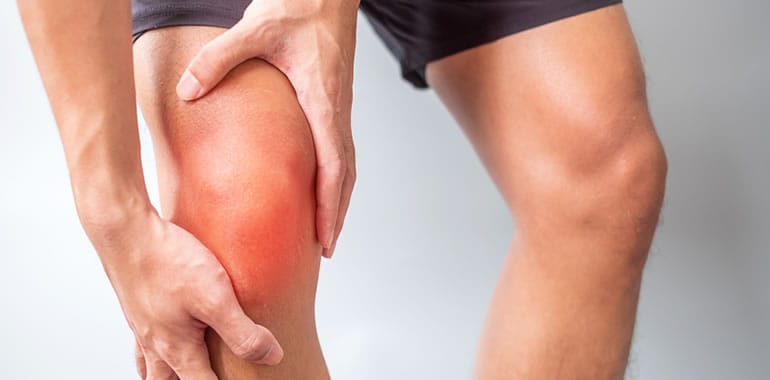
What is the Cause of Runner's Knee or PFPS
The patella femoral joint is the region where the pain is thought to originate and the pain generator for this common condition among runners and the athletic population. The patella femoral joint is comprised of the distal end of the femur, specifically the medial and lateral condyles which come in contact with the underside of the patella comprising the facets.
During normal movements, the patella or kneecap tracks in between the medial and lateral condyle. It is thought the patella tracks poorly in this trochlear groove causing pain, cracking, grinding, stiffness and achiness in the front of the knee which can also be called anterior knee pain or chondromalacia of the patella. This abnormal tracking causes a “binding” and irritation to the articular cartilage. Often, I give the analogy of an old dresser drawer that gets stuck as you open or close it because it is not tracking well and needs a little correction. In the case of this condition, the main way to improve this is through knee and hip strengthening.
Why Does This Tracking Problem Occur?
It is believed this can occur when increasing the running or sport through too much volume, intensity or frequency, leading to irritation of the patellofemoral joint. We often see this at the start of track or cross country if the athlete has not done enough preseason conditioning, or a marathoner who has a certain training schedule that is too aggressive for his or her abilities. Also, this is seen after a period of rest from an illness or after a stop in training after the winter if the athlete returns to their previous training schedule without allowing for a period of rest. The current thought is that there is an imbalance or weakness of the surrounding structures, specifically the musculature that can lead up to developing this problem. In addition, it is believed that the timing of the muscular in the trunk and lower extremities can alter the patella tracking. We have also noted changes in footwear, running surfaces and addition to hill or speed work can trigger a start of this condition.
What Things Can You do to Manage Pain in the Early Stages?
It is very important to address any contributing factors to Runner’s Knee or PFPS in all of our patients. Many times patients have increased a particular activity too quickly or increased the intensity. Many runners will incorporate speed training that seems to correspond with developing this condition or boot camp classes with a high number of squats, changes in footwear, increases in body weight, or type of running surface. In the early stages, I attempt to provide alternatives to endurance or cardiovascular training activity that may be triggering the knee pain. These can include temporarily moving to a walk / jog program, avoiding hills, decreasing the running pace, or doing an elliptical or stationary bike until the knee pain is more manageable and strength starts to improve. This can vary from 4- 6 weeks depending on the patient’s goals and sport which they would like to return.
In the early stages, patients will get short term relief from patella tracking braces or patella taping via McConnel, Mulligan or Kinesiotaping to take pressure off the joint and promote comfort while doing exercises. Often, this offers a degree of relief but not for everyone. If anyone benefits from these approaches, you should notice immediate changes in pain levels with activities while being taped or braced which many people believe is related to more feedback to the nerve receptors in and around the knee as to the position of the joint, therefore helping with patella tracking that is believed to be at the root of the problem. The use of bracing and taping can potentially create a psychological dependence, contribute to altered movement patterns, and in some cases lead to weakness and cause the patient to delay the long term solution.
Another short term approach patients may benefit from is using over the counter or custom fabricated inserts in their footwear, reducing the excessive movement in the foot and ankle, which is thought to affect the tracking of the patella.
Taking over the counter anti-inflammatories like Motrin, Aleve or generic Ibuprofen can provide short-term relief but does not get to the root of the problem. These early approaches can help in managing pain levels in order to perform the strengthening exercises in the early stages of recovery.
What is the Best Treatment for Runner's Knee?
The treatment of Runner's knee or patellafemoral pain syndrome uses a variety of approaches from stretching, strengthening, biofeedback, soft inserts for the shoe or patella tracking braces. The research shows a combination of quadricep, glute and trunk strengthening to be the gold standard for successful treatment. Oftentimes a stretching program is added to address any restrictions in hamstring, quadriceps, calf, ITband and patella mobility, but there is limited evidence for this improving subjective reports of pain and function. Some have made the argument that these adaptations of shortened muscles may serve adaptation in the performance of a particular sport.
Many feel the need to stretch because of the transient relief experienced of stiffness or pain but does not lead to long term changes in this condition or length of the muscle. Recent studies show certain types of eccentric strengthening over a period can cause improvements in muscle length when studying hamstring tightness. That being said, a stretching program will probably not take away from the strengthening portion of the program except if done just prior to certain sports related activities, especially explosive movements like sprinting and jumping. On a side note, many patients have difficulty complying with physical therapy home exercise programs beyond 2-3 exercises. With this in mind, I will omit stretching to focus on strengthening except when significant flexibility restrictions are evident.
What is the Typical Strengthening Program for Runner’s Knee?
We break down the various stages into stage 1 the pain control and early open kinetic chain strengthening. Followed by stage 2 followed by closed chain or functional strengthening and lastly the Stage 3 the return to sport or plyometric stage.
Stage 1
In this stage we perform mostly open kinetic chain exercises that are not weight bearing until patients with acute symptoms in the patella or kneecap region decrease or are more intermittent. This stage can last for 1-2 weeks or longer if the condition is more chronic and the patient is potentially more deconditioned. The athlete that has recently developed PFPS is very different from the one who has had this condition for 3-6 months and has severely restricted their activities. Here is a list of the exercises we often start with to be performed 2-3 times a week. Most times I instruct patients that mild pain experienced during these exercises is normal but should resolve soon after the completion of the exercise session and should never result in joint swelling.
All exercises should be performed for 3 x 10 reps, decreased reps or sets if necessary. There are variations whereby the clinician will progress to a higher number of reps in the 15-20 range prior to adding additional resistance besides bodyweight. Another variation is adding isometric holds at the end of the range motion for 5-10 seconds. Once a patient can do those base exercises easily, we will add resistance via elastic exercise bands or ankle weights. These exercises attempt to isolate quadriceps strengthening.
There is evidence that compound movements like squats, wall squats and leg press patterns do not always activate the quadricep musculature during these movements patterns. It is believed that the hip extensors, knee flexors and calf musculature can reduce the need for quadriceps activation during these movements. This may be due to compensatory movements patterns adopted especially for chronic injuries greater than 2-3 months, current pain and swelling inhibition reducing the quadriceps activation, force production or timing. Therefore it is essential to make sure you have adequate strength when performing these stage 1 exercises, sometimes into stage 2. If you are having difficulty progressing in stage 2 exercises, you may have to return to stage 1.
In certain situations, the patient has to go to 2x/week with greater rest in between exercise sessions for greater recovery, especially in the older more deconditioned population. As we progress to stage 2, we eventually phase out the stage 1 exercises but typically there is an overlap in the early portion of stage 2. At this point, we also want the patients to discontinue or wean off of anti-inflammatories and slowly attempt to participate in sports related activities without knee bracing and taping, especially as we introduce more compound exercises or functional movement patterns.
Stage 2
In Stage 2 we progress to weight bearing exercises:
Stage 3
It is not necessary to go through stage 3 if your activity is hiking or biking which doesn’t include quick change in direction or dynamic loading requirements. However, it is recommended for our joggers, runners, tennis, basketball, skiing, Crossfit and boot camp athletes to ensure they have reasonably comfortable and healthy movement patterns. If you are progressing in this stage, avoid any external resistance like weight jackets, ankle weights or dumbbells while performing plyometric exercise type movements.
For our runners, we have to look into the proper fit for running shoes and possible custom or general soft inserts. We recommend to our runners a weaning of new running shoes over a month period of alternating runs with an old pair of shoes and new shoes to allow a gradual phasing out. Another recommendation is to purchase new shoes every 500 miles, so tracking your runs is essential. Many runners don’t appreciate how much their running shoes have broken down until they get a new shoe.
In cases where you find a really good shoe that fits your running style and shoe size, buy a few pairs just in case the model gets discontinued or altered in subsequent years. Be aware that changes in your feet do occur with age and the type of shoe you need in your 20’s may be different in your 40’s or 50’s from degree of support. When in doubt, have your foot measured especially if you are having bruising, numbness and tingling in your toes that does not seem related to any other changes in your training.
Best of luck!


